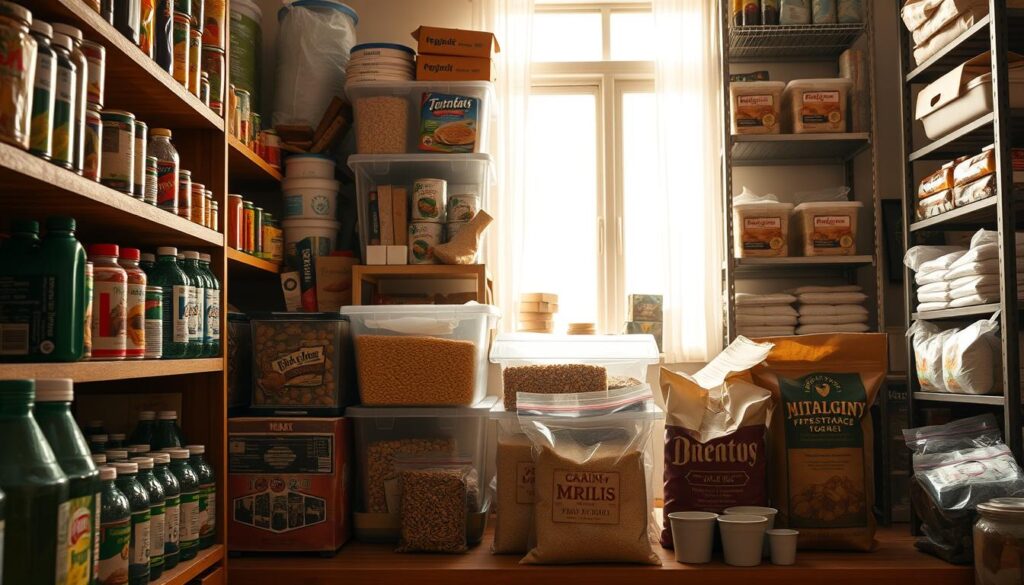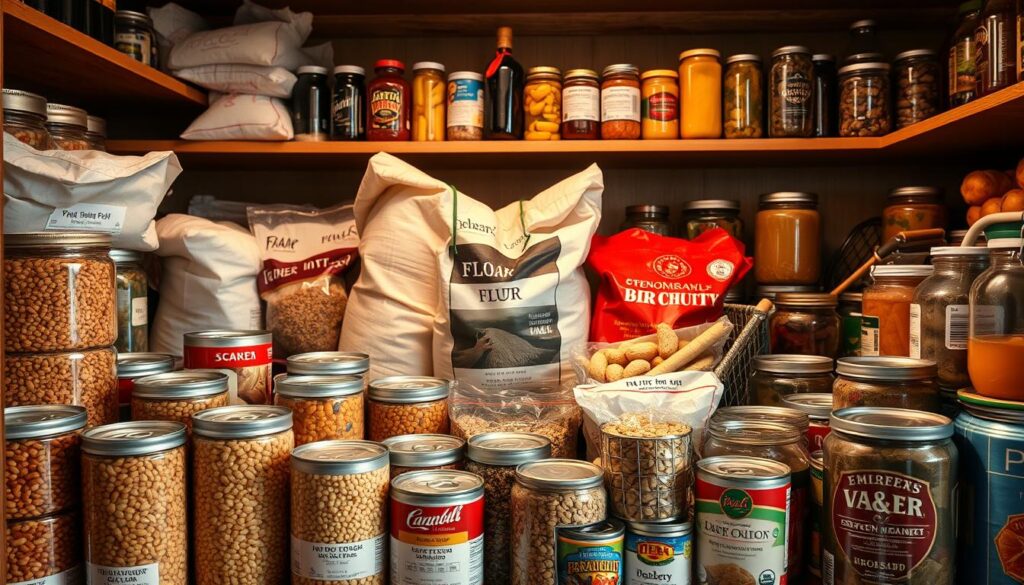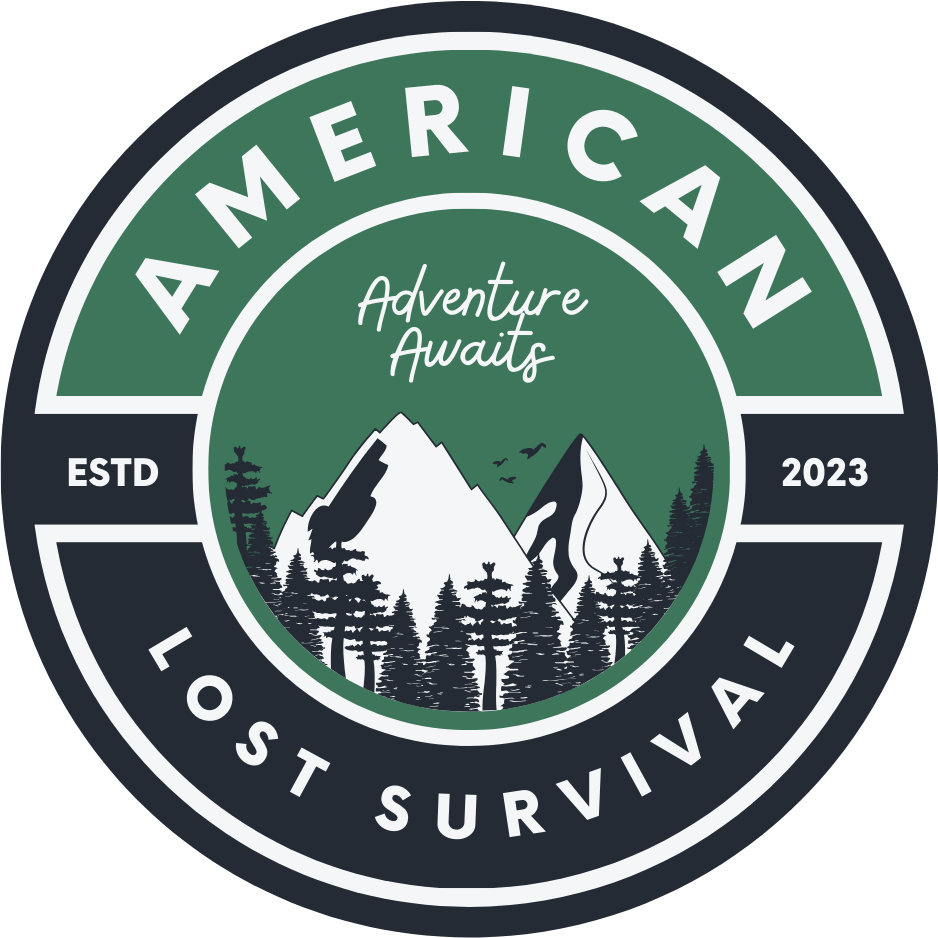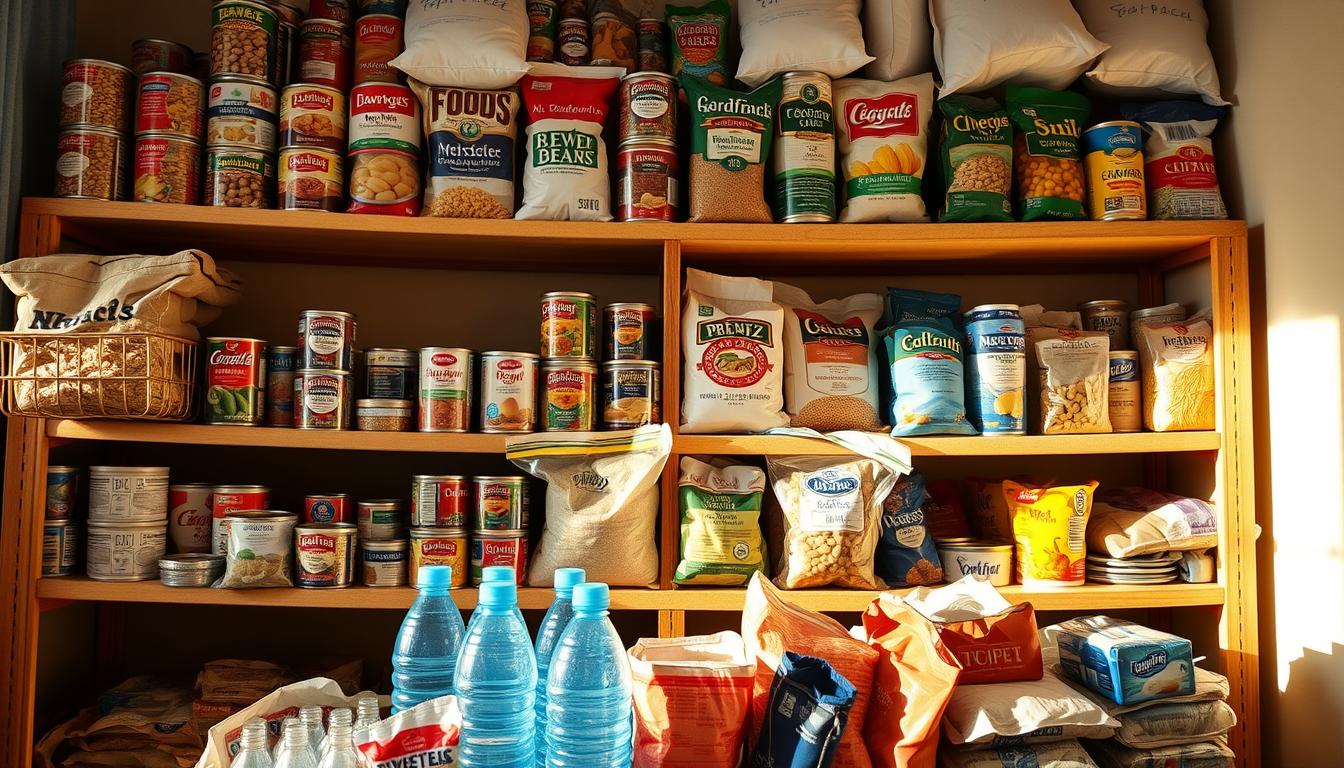Imagine if disaster hit and all the grocery stores were empty. Are you ready to feed your family in such a crisis?
Being prepared for emergencies is more than just survival. It’s about keeping your family’s nutrition and hope up. Long lasting foods are key when you can’t get to the store. They help you stay strong when times are tough.
Knowing what to stock up on is key to emergency food planning. Your pantry can be a lifesaver when stores run out. Choosing the right foods means you get more than just calories. You get the nutrients your body needs.
Key Takeaways
- Emergency food preparedness is key for family survival
- Shelf-stable foods can last for decades if stored right
- Nutrition is important, even in emergencies
- Proper storage makes food last longer
- Have a variety of emergency foods for balanced nutrition
Essential Principles of Emergency Food Storage

Storing non-perishable food needs careful planning. Your first step is to know what affects food the most. Things like temperature, humidity, and light are key to keeping food good.
For the best storage, keep food cool and dark. Avoid sunlight and moisture. Good spots include pantry shelves, basements, or special storage areas. Temperatures between 50-70°F are best for most foods.
Use airtight containers to keep food safe from moisture and germs. Oxygen absorbers can also help keep dry foods fresh longer. Always use the oldest food first to keep everything fresh.
Look closely at how you package food. Foods in vacuum-sealed or mylar bags last longer. Check your food often for damage, moisture, or pests. Good storage can make food last for years, helping you in emergencies.
Remember, different foods need different care. Some can last forever, but others need more attention. Knowing this helps you build a strong emergency food supply. This way, you stay nourished when you need it most.
=> 26 Superfoods That You Can Store Without Refrigeration for Years (Video)
Long Lasting Foods for Your Emergency Pantry

Creating a strong emergency food supply begins with knowing which foods last long. Wheat berries are a top choice, lasting up to 30 years if stored right. They are a key part of long-term food storage plans.
Canned goods are also vital for emergency prep. Most canned items stay good for two years, giving you a steady food source. Freeze-dried meals last even longer, 20-30 years, and are light and easy to store.
Dehydrated foods like beans and rice are packed with nutrients. One cup of pinto beans has about 240 calories, making them a great energy source. Textured Vegetable Protein (TVP) can last up to 20 years, adding a versatile protein option to your pantry.
Keeping your food safe is essential for its longevity. Protect it from heat, light, moisture, and oxygen. Use mylar bags with oxygen absorbers to keep dry goods fresh longer. The right packaging can turn many foods into long-term storage options.
Your emergency food stock should offer nutrition, taste, and long storage. Combine canned goods, freeze-dried meals, and dehydrated foods for a complete and lasting food supply. This mix will help you face unexpected challenges.
Related: The Lost Superfoods
Nutritional Balance in Emergency Food Storage
When you’re getting ready for emergency food, it’s key to focus on nutritional balance. You want to stock up on foods that give you the right mix of nutrients. Experts say aim for 2000-2400 calories a day to keep you going during tough times.
Choosing the right foods for long-term survival is important. You should pick a variety of foods that have proteins, carbs, and fats. Include items like dried beans, canned meats, and whole grains. These help make sure you get the nutrients you need, even when times are hard.
Adding multivitamins to your emergency food is a good idea. Try to store 365 tablets per person, checking the expiration dates. Freeze-dried foods are great because they can last up to 25 years if stored right.
When you’re building your emergency food stash, think about variety and nutrition. Use tools like MyPlate to help pick foods from different groups. Remember, just because a food is high in calories doesn’t mean it’s good for you. Aim for a balanced mix that keeps you healthy, no matter what.
Best Storage Methods and Containers
Choosing the right storage is key to keeping your food fresh. Glass containers, like the Oxo Good Grips 16-Piece Set, are great for this. They keep moisture and air out, helping your food stay good longer.
Vacuum sealing is another smart way to store food. The Zwilling Fresh & Save set removes oxygen, which helps food last longer. Stasher Reusable Bags are also good for storing food, being both durable and eco-friendly.
For storing a lot of food, Cambro Square Containers are perfect. They hold up to 8 quarts, great for big amounts of flour and grains. Mason jars are also a classic choice, ideal for smaller amounts and keeping things organized.
Keeping food at the right temperature is important. Store it in cool, dark places at about 70°F. Use containers that seal well to keep out moisture and bugs. Also, use a system to use older food first to keep your supply fresh.
Pro tip: Mark your containers with when you bought and opened them. This helps you know how fresh they are. Good storage solutions mean your food stays safe and you can feel secure in emergencies.
Conclusion
Building a strong emergency food supply is more than just storing food. It’s about creating a safety net for you and your family. By choosing foods that last long and are nutritious, you keep your family safe in tough times.
Your emergency food should be well-thought-out. It’s important to have a variety of foods like fruits, grains, and proteins. This mix helps keep your diet balanced. Whole grain products, for example, can offer important health benefits when food is scarce.
Storing your food right is also key. Check your supplies often, follow food rotation rules, and use the right containers. This keeps your food safe and good to eat. The aim is to have a food supply that’s both nutritious and ready when you need it.
By following this guide, you’re not just getting ready for emergencies. You’re making your family’s future more secure. Your efforts turn uncertainty into confidence, making you ready for any challenge.







